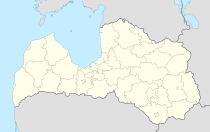Jēkabpils
| Jēkabpils ( German : Jakobstadt) | ||
|---|---|---|
 |
|
|
| Basic data | ||
| State : |
|
|
| Landscape: | Semgallia ( Latvian : Zemgale ) | |
| Administrative district : | Republic-city of Jēkabpils | |
| Coordinates : | 56 ° 29 ' N , 25 ° 51' E | |
| Residents : | 23,538 (Jul. 1, 2018) | |
| Area : | 23 km² | |
| Population density : | 1,023 inhabitants per km² | |
| Height : | 77 m | |
| City law: | since 17th century | |
| Website: | www.jekabpils.lv | |
| Post Code: | 5201-5222 | |
| ISO code: | LV-JKB | |
| Jakobstadt and Kreutzburg (by Johann Cristoph Brotze ) | ||
Jēkabpils (German: Jakobstadt ) is a city in eastern Latvia , on the Daugava river halfway between Riga and Daugavpils . It is considered the unofficial capital of the Sēlija region . In 2018 Jēkabpils had 23,538 inhabitants.
The historical parts of Jēkabpils and the northern incorporated Krustpils lie on both sides of the Daugava , which is spanned by a bridge here. South of the Daugava is also the Jēkabpils novads administrative district , which is administratively separated from the city. As one of the 9 Latvian “Republic Cities”, this forms a separate unit.
history
The area was part of the Jersika state . In 1237 the Knights of the Livonian Order had a stone castle, "Cruczeborch" ( Kreutzburg ), built on the right bank of the river .
When Livonia was divided in 1561, the region south of the Daugava became part of the Duchy of Courland and Zemgale . In 1655 the settlement of Sloboda is mentioned, which consisted of war refugees. During the 17th century , Old Believers persecuted in Russia also settled in Sloboda. Until 1670 the settlement gradually grew around an inn called Salas Krogs ( Inselkrug ) to a town on the left bank of the river. The Duke of Courland , Jakob Kettler , who gave it city rights, gave it the name Jakobstadt.
In the Great Northern War , Jakobstadt was conquered by the Swedes in 1700 and then by the Russians in 1704. After the battle near Jakobstadt that followed shortly afterwards, however, the advance was over. A plague epidemic raged in 1710, but after the end of the war in 1721 the economy recovered. In 1764 a ferry to Kreutzburg was set up.
From 1796 Jekabpils belonged to the Russian Governorate of Courland . The construction of the railway line on the other side of the Daugava reduced the importance of Jekabpils in terms of transport. Nevertheless, there was an economic upswing up to the beginning of the First World War . 280 buildings were destroyed in the fighting on the Daugava during this war. From July 1919 the Baltic State Army used Jekabpils as a base for a defensive position to the east.
In 1932 a sugar factory was built and in 1936 a bridge with a narrow-gauge connection to Krustpils was built.
The bridge was destroyed in World War II, but rebuilt in 1962. In this year Krustpils was incorporated. Large companies included a large sewing factory, a precast reinforced concrete factory, a dairy factory, and a canning factory. After Latvia gained independence in 1991, many companies were closed.
coat of arms
Description: A golden lynx on a green shield base stands in front of a green fir tree in blue . According to a local legend about the origins of the city, the duke once got lost while hunting. On the Daugava he saw a lynx under a fir tree and a city at the same time. The image of the lynx under the fir tree can be found today on the city arms.
Attractions
Buildings have been preserved in the oldest part of the city. In Tadenava, not far from Jēkabpils, there is the Rainis Memorial Museum , between Nereta and Aknīste that of Jānis Jaunsudrabiņš with the name "Riekstiņi". Other attractions in the area include the castles of Justine and Dignāja and the highest point of Sēlija, the Ormaņkalns , in the Klauce area . The Struve arch , an elongated network of geodetic survey points, has a measuring point here.
Twin cities
- Sokołów Podlaski , Poland, since 1987
- Melle , Germany, since 1994
- Maardu , Estonia, since 2003
- Czerwionka-Leszczyny , Poland, since 2004
- Lida , Belarus, since 2005
sons and daughters of the town
- Catherine I (Russia) (1684–1727), wife of Tsar Peter the Great
- Ewald Sigismund Tobien (1811–1860), German-Baltic legal scholar
- Aivars Lembergs (* 1953), politician and entrepreneur
- Solomon Israilewitsch Ginsburg (* 1959), Russian historian and politician in the Kaliningrad Oblast
- Andrejs Piedels (* 1970), soccer goalkeeper
- Andris Džeriņš (* 1988), ice hockey player
- Deniss Rakeļs (* 1992), soccer player
literature
- Hans Feldmann , Heinz von zur Mühlen (Hrsg.): Baltic historical local dictionary. Part 2: Latvia (South Livland and Courland). Böhlau, Cologne 1990, ISBN 3-412-06889-6 , pp. 239-240.
- Astrīda Iltnere (ed.): Latvijas Pagasti, Enciklopēdija. Preses Nams, Riga 2002, ISBN 9984-00-436-8 .
Footnotes
- ↑ Latvijas iedzīvotāju skaits pašvaldībās (= population figures of the self-governing districts of Latvia), status: July 1, 2018 (Latvian), p. 1, accessed on January 5, 2019.

